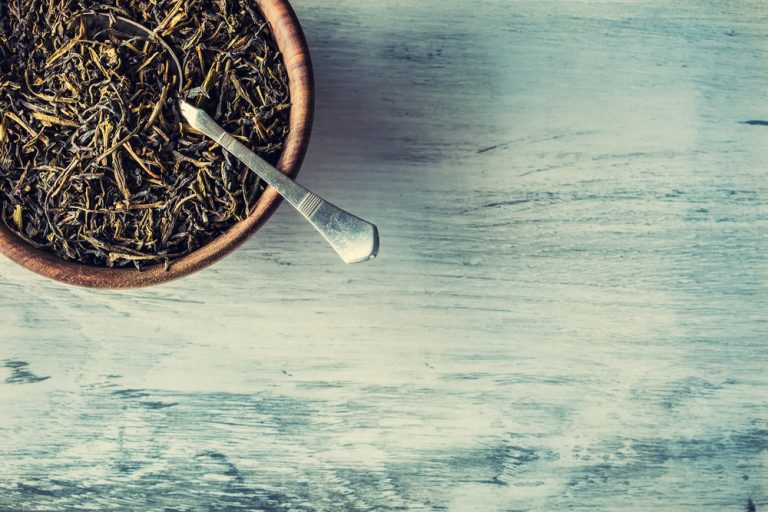Black tea is a highly aged variety of tea and is the most oxidized out of all the other teas like green, white and oolong teas. Because of this intense oxidation, the flavor profile of black tea is much stronger than other tea varieties.
Black tea is known for their strong flavors. Its liquor is characterized as having dark amber color, robust and full-bodied texture, smoky aroma with a distinct malty flavor, and an astringent aftertaste. Black teas caffeine amount is also higher than most other tea varieties. Although black tea is caffeinated, the caffeine content is much lesser than coffee. To cut such brisk flavors, black tea is typically consumed with an additive like milk to mellow the taste. It can be sweetened with honey or sugar, and for those who don’t like milk, lemon is a great option.
Black teas, for long, have been the popular choice for as breakfast and afternoon teas. This is because it can accommodate a range of flavor combinations and additives better than a green tea, white, or oolong can. Take Assam tea, for instance, one of the most popular black tea varieties in the entire world. Assam tea blends have long been used for English Breakfast Tea blends and Irish Breakfast Teas. It’s also the classic choice for various chai blends.
Then there are the Darjeeling first flush and Darjeeling second flush teas – two of the most prized black tea varieties in the world. With well-rounded, complex flavors and fine texture, Darjeeling black tea has been the staple choice for royalty all over the world. Another famous black tea is the British black tea originating from Assam, Ceylon and Kenya.
How is black tea made?
Black tea processing is a long and protracted process that involves multiple steps. It starts with the plucking of the leaves of the Camellia sinensis plant, which are then are moved to a tea processing unit for further treatment.
Witherin: Plucked tea leaves are withered by blowing hot air over them. This helps reduce the moisture content in the leaf, making it pliable for the subsequent process of rolling.
Rolling: Black tea is further processed into one of two styles – Orthodox or CTC. To produce orthodox teas, the withered tea leaves are heavily rolled either by hand or mechanically through the use of a cylindrical rolling table or a rotorvane.
For CTC (Cut, Tear and Curl / Crush, Tear and Curl) tea, the withered leaves are shred using the rotorvane, into very fine particles of even size. This method is commonly adopted for producing lower grade tea dust and fannings.
Oxidation: Next, the leaves are oxidized under controlled conditions of temperature, oxygen level, and humidity. This step is responsible for the browning of leaves and the development of flavor and aromatic compounds.
Drying: The oxidized leaves are left to dry until all moisture is removed from them.
Once the leaves are processed, they are sorted according to tea grades (whole leaf grade, broken leaf grade, fannings and dust).
Indian Black Tea Grades
The broad distinction is whole leaf and broken leaves. Whole leaf grades have better flavor and aroma but less body. This is also why they are best drunk plain and not with milk. Broken tea grades have more strength and accommodate milk well since they have more body than the whole leaf grades. They go into making blends like chai and iced teas.
In India, black tea quality is identified through their grades. In descending order, whole leaf teas are graded as SFTGFOP1, SFTGFOP, FTGFOP1, FTGFOP, TGFOP, GFOP, FOP, OP. OP, FOP, GFOP, TGFOP, TGFOP1, FTGFOP, FTGFOP1, SFTGFOP and SFTGFOP1. Broken leaves have their own grading system going down from OP to BOP, BOP1, FBOP, GBOP, Golden Flowery Broken Orange Pekoe (GFBOP), Tippy Golden Broken Orange Pekoe (TGBOP), Broken Pekoe (BP), Broken Souchong (BS). Right at the end of the scale are the dubious sounding Fannings (F) and Dust (D). (More on this can be found in our introduction to tea grades.)
If you like a mellow, soft and sweet black tea, choose one with F or G in its grade. These have a greater volume of buds that offer those flavors and taste. If you like a mellow aromatic cup with a golden yellow liquor and great flavor, choose the best grade, SFTGOP, made with the ‘fine plucking’ of two leaves and a bud.
What is Black Tea Good for?
A reasonable question to ask when you have so many other varieties of teas out there. Just like green tea, the black tea antioxidants offer a number of health benefits that will make you fall in love with this strongly flavored tea. Whether you use black tea powder or loose leaf black tea, the benefits you’ll get from making it a part of your diet will are amazing. Black tea can help boost your heart health, reduce the risk of diabetes, relieve stomach issues, reduce stress hormones and much more.
Now, that you know everything there is to know about black tea, there’s nothing stopping you from making a nice cup and enjoying it. Don’t stress too much about how to make black tea, the process is as simple as drinking it. Whether you like your black tea with milk or you prefer black tea with lemon, there are a lot of black tea recipes on the internet that will help you in brewing black tea. The famous Chinese black tea known as black dragon tea is a famous tea popular around the world for its strong taste and definitely one that should go on the list of “types of black tea you must try.” And if you’re worried about the caffeine present in the black tea extracts, don’t because there are many decaf black tea blends available on the market.

Comments are closed.